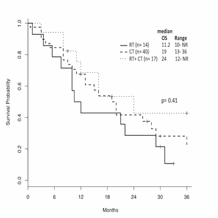Abstract
Background: The presentation of acute myeloid leukemia (AML) as an extramedullary tumor occurs in up to 9% of cases, making it an uncommon event and one that poses difficulties in clinical decision-making. Current data on treatment and outcomes for myeloid sarcoma are based largely on case reports and clinician experiences involving a small number of patients. Radiation is often added to standard chemotherapy regimens in order to attempt to improve rates of complete remission, however there is a paucity of data to guide the utilization of radiation therapy in addition to chemotherapy.
Aims: To determine the impact of chemotherapy, the combination of chemotherapy and radiation therapy, and transplantation on the survival of patients with myeloid sarcoma.
Methods: Beginning with a PubMed search from 1985 to 2014, we performed a review of the literature on cases of isolated myeloid sarcomas (without bone marrow involvement) presenting as the initial diagnosis of AML. We identified 7 large case reports or reviews where individual patient characteristics (including treatment course, site of disease, overall survival (OS) and time to development of bone marrow involvement) were defined.
We also undertook a chart review of the patients treated at Memorial Sloan Kettering Cancer Center from 1990 to July 2014 who upon initial presentation of AML demonstrated extramedullary involvement. We excluded patients with extramedullary disease at relapse, those presenting with lymph node, splenic disease or leukemia cutis in both data sets. For the MSKCC data, we included those who presented with bone marrow involvement due to the low number of patients available for analysis.
Results: The literature search identified 71 analyzable patients and there was no significant difference in OS whether patients with isolated myeloid sarcoma were initially treated with radiation therapy (n= 14, 11.2 months), chemotherapy (n=40, 19 months) or the combination of chemotherapy and radiation (n=17, 24 months, p=0.41) Fig 1. The median OS of these patients was 16 months (n=71).
At MSKCC, 27 patients were available for analysis. The median 3 year OS of patients presenting with AML and extramedullary involvement was 41%. There was a significant improved 1 year OS (p=0.002) if patients were treated with chemotherapy alone (n=19), as opposed to the combination of radiation and chemotherapy (n=6), 89% vs. 33%, respectively. There was no difference in OS if patients presented with bone marrow involvement or with isolated disease (35% vs. 55% at 3 years, p= 0.51). Lastly, patients who underwent allogeneic stem cell transplantation (n=13) exhibited a median 44% 3 year OS. Only seven of these patients were in first complete remission.
Summary/ Conclusion: Patients with AML who present with extramedullary disease seem to derive no additional survival benefit from the inclusion of radiation therapy to chemotherapy as initial treatment. Also, presentation with isolated myeloid sarcoma does not appear to confer a worse prognosis when compared to myeloid sarcoma with bone marrow involvement and likely represents a different manifestation of the same disease process. For comparison, regarding overall survival, patients enrolled in ECOG 1900 who received standard therapy had a median OS of 15.7 months and those with intermediate risk cytogenetics and an intermediate risk mutational risk profile, as described by Patel et al in NEJM 2012, had a 3 year OS of 42% comparable to the outcomes we noted above. This suggests that patients with myeloid sarcoma do no worse than those with bone marrow only disease.
The survival of patients who underwent allogeneic stem cell transplantation in our study had a similar median 3 year OS to patients with AML who undergo allogeneic stem cell transplantation studied by the CIBMT and published in Blood 2012 by Saber et al. The 3 year OS rates for patients who underwent a matched related donor transplant in this publication was 39%, and 37% for those who had a matched unrelated donor transplant.
In summary, though the sample size is notably small and acknowledging the limitations of retrospective data, patients with myeloid sarcoma during the initial presentation of AML should undergo risk stratification and treatment in the same manner as patients with AML without extramedullary disease.
No relevant conflicts of interest to declare.
Author notes
Asterisk with author names denotes non-ASH members.


